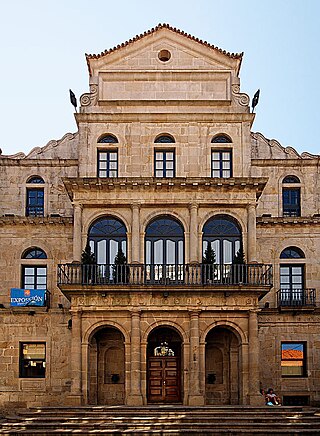
Pontevedra is a city in the autonomous community of Galicia, in northwestern Spain. It is the capital of both the Comarca and Province of Pontevedra, and the capital of the Rías Baixas. It is also the capital of its own municipality which is often considered an extension of the actual city.

The church of the Pilgrim Virgin is a scallop-shaped Roman Catholic chapel located in the city of Pontevedra, in Spain, along the route of the Portuguese Way of St. James.

The Palace of Mugartegui, or Palace of the Counts of Fefiñáns in Pontevedra, Spain, is a Baroque pazo dating from the 18th century. It currently houses the headquarters of the Regulatory Council of the Rías Baixas Designation of Origin.

The Praza da Ferrería is a large square located on the edge of the old town of Pontevedra (Spain), inside the old city walls. It is the main square of the old town and has an area of about 2,000 m2. It includes the small squares of the Estrella on the north side, the Orense square on the south side and the Casto Sampedro square on the east side, making a total of almost 5,000 m2.

The Plaza de Toros de Pontevedra (Spain) is the bullring of the Spanish city of Pontevedra and the only one in the autonomous community of Galicia. It has a capacity of 7,800 spectators and is classified as the second category of Spanish bullring. The current bullring replaced a wooden one dating from 1892, although the tradition of bullfighting in Pontevedra dates back to the 17th century.

The Ravachol parrot lived in Pontevedra, Spain, between 1891 and 1913. It was the pet of pharmacist Perfecto Feijoo. It became one of the symbols of the city.

The walls of Pontevedra were a fortification of the city of Pontevedra (Spain), which disappeared for the most part towards the end of the 19th century, although some remains are still visible, the most important being the crenellated section in Arzobispo Malvar Street. This complete section, approximately 40 metres long, can be accessed from the gardens of the two buildings on the west side of Santa María Avenue.

The Bank of Spain building is an eclectic early-20th-century building in the Spanish city of Pontevedra.

The Plaza de la Verdura is a square of medieval origin located in the heart of the historic centre of Pontevedra (Spain). It is one of the liveliest medieval squares in the city.

The historic centre of Pontevedra (Spain) is the oldest part of the city. It is the second most important old town in Galicia after Santiago de Compostela, and was declared a historic-artistic complex on 23 February 1951.

The Plaza de Barcelos is a square dating from the beginning of the 20th century located in the city centre of Pontevedra (Spain), to the east of the historic centre of Pontevedra.

The Pontevedra Provincial Hospital is a building dating from 1897, located in the city centre of Pontevedra, Spain.

The Liceo Casino is a neoclassical building from 1878 located in the historic centre of Pontevedra, which houses the oldest cultural and leisure society in Pontevedra, Spain.

The Marquis of Riestra's mansion is an eclectic building with art Nouveau elements from the late 19th century located at 30 Michelena Street in Pontevedra, Spain. It currently houses the main central administrative services of the City Council of Pontevedra.

The Chapel of the Nazarene is a Catholic religious building, with the status of chapel, located in the old town of Pontevedra (Spain), in Duque de Tetuán Street, opposite the Principal Theatre.

The Plaza del Muelle or Praza do Peirao is a square of medieval origin located at the northern edge of the historic centre of Pontevedra (Spain), very close to the Burgo Bridge and the old port neighbourhood A Moureira.

The calle Benito Corbal is a street in Pontevedra (Spain) located in the first urban expansion area of the city. It is one of the main streets of Pontevedra, known as the "Golden Mile".

The Calle de la Oliva is a street in Pontevedra (Spain) located in the city centre, on the edge of the old town. It is one of the main streets of Pontevedra and one of the most commercial.

The Calle Michelena is a street in Pontevedra (Spain) located in the city centre, on the edge of the old town. It is one of the main streets of Pontevedra and one of the most commercial streets of the city.

The Ensanche of Pontevedra is the neighbourhood that forms the centre of the Spanish city of Pontevedra, made up of several successive extensions to the city outside the old town. The term Ensanche means " widening " in Spanish and refers to the expanding areas of Spanish cities towards the end of the 19th century, when the demographic explosion and the industrial revolution led to the demolition of the old city walls and the construction of new areas outside the old fortified walls.




























